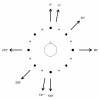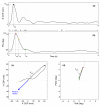Biofeedback improves postural control recovery from multi-axis discrete perturbations
- PMID: 22863399
- PMCID: PMC3477042
- DOI: 10.1186/1743-0003-9-53
Biofeedback improves postural control recovery from multi-axis discrete perturbations
Abstract
Background: Multi-axis vibrotactile feedback has been shown to significantly reduce the root-mean-square (RMS) sway, elliptical fits to sway trajectory area, and the time spent outside of the no feedback zone in individuals with vestibular deficits during continuous multidirectional support surface perturbations. The purpose of this study was to examine the effect of multidirectional vibrotactile biofeedback on postural stability during discrete multidirectional support surface perturbations.
Methods: The vibrotactile biofeedback device mapped tilt estimates onto the torso using a 3-row by 16-column tactor array. The number of columns displayed was varied to determine the effect of spatial resolution upon subject response. Torso kinematics and center of pressure data were measured in six subjects with vestibular deficits. Transient and steady state postural responses with and without feedback were characterized in response to eight perturbation directions. Four feedback conditions in addition to the tactors off (no feedback) configuration were evaluated. Postural response data captured by both a force plate and an inertial measurement unit worn on the torso were partitioned into three distinct phases: ballistic, recovery, and steady state.
Results: The results suggest that feedback has minimal effects during the ballistic phase (body's outbound trajectory in response to the perturbation), and the greatest effects during the recovery (return toward baseline) and steady state (post-recovery) phases. Specifically, feedback significantly decreases the time required for the body tilt to return to baseline values and significantly increases the velocity of the body's return to baseline values. Furthermore, feedback significantly decreases root mean square roll and pitch sway and significantly increases the amount of time spent in the no feedback zone. All four feedback conditions produced comparable performance improvements. Incidences of delayed and uncontrolled responses were significantly reduced with feedback while erroneous (sham) feedback resulted in poorer performance when compared with the no feedback condition.
Conclusions: The results show that among the displays evaluated in this study, no one tactor column configuration was optimal for standing tasks involving discrete surface perturbations. Feedback produced larger effects on body tilt versus center of pressure parameters. Furthermore, the subjects' performance worsened when erroneous feedback was provided, suggesting that vibrotactile stimulation applied to the torso is actively processed and acted upon rather than being responsible for simply triggering a stiffening response.
Figures






Similar articles
-
Effects of multi-directional vibrotactile feedback on vestibular-deficient postural performance during continuous multi-directional support surface perturbations.J Vestib Res. 2008;18(5-6):273-85. J Vestib Res. 2008. PMID: 19542601
-
Assessment of vibrotactile feedback on postural stability during pseudorandom multidirectional platform motion.IEEE Trans Biomed Eng. 2010 Apr;57(4):944-52. doi: 10.1109/TBME.2009.2036833. Epub 2009 Nov 20. IEEE Trans Biomed Eng. 2010. PMID: 19932987
-
A mathematical model for incorporating biofeedback into human postural control.J Neuroeng Rehabil. 2013 Feb 2;10:14. doi: 10.1186/1743-0003-10-14. J Neuroeng Rehabil. 2013. PMID: 23374173 Free PMC article.
-
Balance retraining after stroke using force platform biofeedback.Phys Ther. 1997 May;77(5):553-8. doi: 10.1093/ptj/77.5.553. Phys Ther. 1997. PMID: 9149764 Review.
-
A review of concurrent sonified biofeedback in balance and gait training.J Neuroeng Rehabil. 2025 Feb 26;22(1):38. doi: 10.1186/s12984-025-01565-4. J Neuroeng Rehabil. 2025. PMID: 40011952 Free PMC article. Review.
Cited by
-
The effect of age on postural and cognitive task performance while using vibrotactile feedback.J Neurophysiol. 2015 Apr 1;113(7):2127-36. doi: 10.1152/jn.00083.2014. Epub 2015 Jan 14. J Neurophysiol. 2015. PMID: 25589585 Free PMC article.
-
Vibrotactile Feedback for Improving Standing Balance.Front Bioeng Biotechnol. 2020 Feb 21;8:94. doi: 10.3389/fbioe.2020.00094. eCollection 2020. Front Bioeng Biotechnol. 2020. PMID: 32154229 Free PMC article.
-
Effects of long-term balance training with vibrotactile sensory augmentation among community-dwelling healthy older adults: a randomized preliminary study.J Neuroeng Rehabil. 2018 Jan 18;15(1):5. doi: 10.1186/s12984-017-0339-6. J Neuroeng Rehabil. 2018. PMID: 29347946 Free PMC article. Clinical Trial.
-
A Vibrotactile and Plantar Force Measurement-Based Biofeedback System: Paving the Way towards Wearable Balance-Improving Devices.Sensors (Basel). 2015 Dec 15;15(12):31709-22. doi: 10.3390/s151229883. Sensors (Basel). 2015. PMID: 26694399 Free PMC article. Clinical Trial.
-
Potential Mechanisms of Sensory Augmentation Systems on Human Balance Control.Front Neurol. 2018 Nov 12;9:944. doi: 10.3389/fneur.2018.00944. eCollection 2018. Front Neurol. 2018. PMID: 30483209 Free PMC article. Review.
References
Publication types
MeSH terms
Grants and funding
LinkOut - more resources
Full Text Sources

